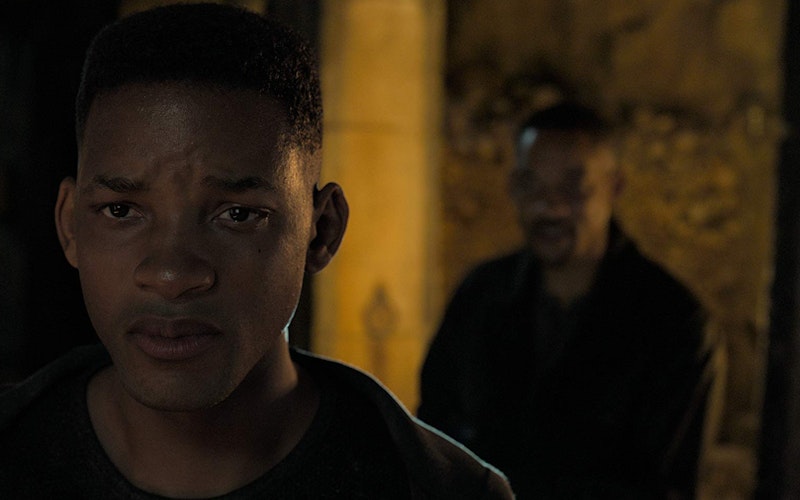
Movies
Gemini Man and the Action of Confession
Whether it’s the Man with No Name or John Wick, we love individualist heroes at the movies—someone who defies the laws of society and physics to take down bad guys no one else can beat. Initially, Gemini Man’s protagonist—super-assassin Henry Brogan (Will Smith)—seems like the next figure in this long line of loners, a guy so cool that he can snipe a target riding a high-speed train. But under the guidance of director Ang Lee, Gemini Man is less a movie about an exceptional killer and more about a lonely man desperate for forgiveness.
To be sure, Brogan is an individualist hero, unmatched as an operative for the fictional Defense Intelligence Agency. But that’s mostly in the past. The movie opens with Brogan in his 50s, realizing that he lacks close relationships and possesses a conscience haunted by memories of his many victims. With no one to help him exorcise these ghosts, Brogan retires, hoping to forget his past in the safety of his solitary Georgia home.
And that’s when his past returns, in the form of a soldier coming to kill him. We’ve seen this trope before, in which vengeful victims or an old adversary pulls an aged hero back into action. But Gemini Man puts an introspective spin on the story by having Brogan be pursued by himself. More accurately, he’s hunted by Junior, a heretofore unknown clone of Brogan, 20 years younger (played by a digitally de-aged Smith). The movie first sets up Junior as a continuation of the individualist hero archetype, claiming that he’s the only person skilled enough to defeat Brogan. But then it subverts that idea, reimagining Junior as a man who has not yet made Brogan’s mistakes.
Brogan’s battles with Junior literalize the struggle of a guilty conscience, transforming spectacular action sequences into representations of a man wrestling with his guilt. When a firefight pins the men against opposite sides of a wall, they make the hallway mirror between them into a field of battle, bouncing grenades off the surface to destroy the man they see reflected there. When the two grapple in hand-to-hand combat, the film slips into slow-motion to emphasize identical pairs of fists slamming into identical faces.
Once Brogan discovers his relationship to Junior, however, his approach changes. He sees Junior as a version of himself who hasn’t spent his life taking lives and avoiding others, and vows to save him. Brogan begins this mission by proving that he and Junior are the same person, demonstrating his knowledge of the younger man, which is, of course, knowledge of himself. After listing mundane facts about bee allergies and romantic shortcomings, Brogan opens up more, acknowledging his desire for connection and the pleasure he takes from killing. “You desperately want to have a relationship,” Brogan tells his younger self, “but you’re terrified that someone will find out what you really are. So you make everyone else a target. And you are a weapon.”
In other contexts, Brogan’s words would be accusations. But because he is literally describing himself, these declarations are confessions. When characterizing Junior, Brogan’s actually admitting that he has hurt people, that he is lonely and weak, that he needs forgiveness.
Spectacular action sequences become representations of a man wrestling with his guilt.
According to Dutch theologian Henri Nouwen, confession and forgiveness are necessary practices to “overcome the temptation of individual heroism.” For Nouwen, Christian leaders—those who seem the most spiritually strong—can actually be among “the least confessing people in the Christian community” because they fear the vulnerability confession involves. This avoidance results in “an increasing split between their own most private inner world and the good news they announce,” a split that can only heal with confession and forgiveness. These, Nouwen claims, are “the concrete forms in which we sinful people love one another.”
Gemini Man gestures toward these practices and the reunification they engender with its visual language. Whenever a character makes an admission or a plea, Lee and cinematographer Dion Beebe employ shot/reverse shots featuring medium close-ups of the speaking and listening characters, who stare directly at the camera (and, by extension, at the audience). In the aforementioned confession scene, Lee rarely puts Brogan and Junior in the same shot. Instead, the frame is filled with Smith’s face, highlighting his characters’ longing for connection. These moments focus not on the heroes’ individual abilities, but on their admissions and their need for forgiveness.
The visual technique is especially powerful when viewed in the 120-frames-per-second format in which Lee shot the film and intended for it to be projected. The higher frame rate results in far greater clarity, smoothing out movements and capturing minute details lost in the standard, 24-frames-per-second format of most films. It strips away the haze audiences have grown accustomed to, making Gemini Man feel hyper-real. Although the format can be used to make action sequences seem more intense and kinetic, adding greater definition to bodies slamming against each other, Lee also uses it to emphasize the openness of his actor’s faces. When Smith as Brogan confesses his regrets, his eyes squinting to shut out tears, or when Smith as Junior looks up in fearful recognition, we see the vulnerability that Nouwen describes.
In the month since its release, Gemini Man has not done well at the box office, while critics remain divided on its quality. It’s the type of response usually given to a subpar action movie, one that fails to meet the expectations of the genre. Maybe that’s what Gemini Man is. But the movie also redefines the individual hero in a compelling, biblically resonant way, from a man who overcomes his shortcomings to one who stands vulnerable in his confession and waits for a forgiving response.
Topics: Movies